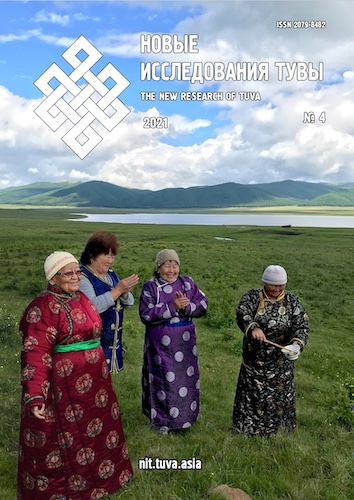Features of the Demographic Development of Tuva: Contribution of Migration to the Demographic Balance
DOI:
https://doi.org/10.25178/nit.2021.4.10Keywords:
internal migration; lifelong migration; labor migration; demographic balance; population census; micro census; Tuva; Tuvan population; TuvansAbstract
The article highlights the features of the population dynamics in Tuva from the mid-20th century to the present taking different components of the demographic balance into account. The main research methods the author uses are the demographic balance equation, which allows us to estimate the ratio between natural and migration growth of the entire population and of urban and rural populations separately, as well as the analysis of lifelong population migrations on the basis of information about place of birth and place of residence. These methods are applied to study demographic processes in Tuva for the first time. The calculations are based on the official statistics — data from the population censuses of 1989, 2002 and 2010, current record of natural population movement and sample surveys.
There are underestimation of those who leave the territory of the Republic of Tuva and overestimation of return migration that “virtually” arises due to the expiration of the temporary registration period of those who have left it earlier. It has been found out that high rates of natural growth, especially in rural regions, are compensated by the migration outflow of the population from villages to cities and outside the Republic.
It is noted that the Republic has the closest migration relations with neighboring Siberian regions, but the significance of both metropolitan agglomerations — Moscow and St. Petersburg — is increasing. At the same time, there is a decrease in the share of those who have come to Tuva from other regions of Russia and an increase in the share of the natives who have left it. The data of the sample survey of the labor force allow us to identify the increasing importance of interregional labor migration for Tuva in recent years. Meanwhile the number of incoming and especially outgoing domestic labor migrants is noticeably lower than in neighboring regions.
The accumulation of a large error in closing the balance due to the long time that has passed since the previous population census and a change in the migration accounting methodology may lead to a significant reevaluation of the population of the Republic if we consider the results of the next population census.
References
Anaiban, Z. V., Guboglo, M. N. and Kozlov M. S. (1999) Formirovanie etnopoliticheskoi situatsii [Shaping the ethnopolitical situation]. Moscow, Center for the Study of Interethnic Relations RAS. Vol. 1: Ocherki istorii postsovetskoi Tuvy [Essays on the history of post-Soviet Tuva]. 420 p. (In Russ.).
Anaiban, Z. V. (2011) Kharakteristika etnodemograficheskikh protsessov Tuvy v sovetskii period [Characteristics of ethnodemographic processes in Tuva during the Soviet period]. New Research of Tuva, no. 2–3, pp. 130–150. (In Russ.).
Anaiban, Z. V. (2020) Sovremennaia migratsionnaia situatsiia v Respublike Tyva [Contemporary migration situation in the Republic of Tuva]. Sciences of Europe, no. 49–4 (49), pp. 62–66. (In Russ.).
Andreev, E. M. (2012) O tochnosti rezul'tatov rossiiskikh perepisei naseleniia i stepeni doveriia k raznym istochnikam informatsii [On accuracy of Russia population censuses results and level of confidence in different sources of information]. Voprosy statistiki, no. 11, pp. 21–35. (In Russ.).
Balakina, G. F. and Anaiban, Z. V. (2016) Osobennosti etnoregional'noi migratsii v Tuve [Specific features of ethno-regional migration in Tuva]. Sotsiologicheskie issledovaniia, no. 10, pp. 85–92. (In Russ.).
Biche-ool, T. N. and Dopchut, A. A. (2015) Izmenenie administrativno-territorial'nogo deleniia Respubliki Tyva [Change in the administrative territorial division of the Republic of Tuva]. Vestnik Zabaikal'skogo gosudarstvennogo universiteta, no. 9 (124), pp. 4–9. (In Russ.).
Denisenko, M. B. and Stepanova, A. V. (2012) Geografiia proiskhozhdeniia zhitelei Moskvy. Rasselenie naseleniia [Geography of the origin of the inhabitants of Moscow. Displacement of population]. Demograficheskie issledovaniia, no. 19, pp. 133–168. (In Russ.).
Kan, V. S. (2014) Migratsiia kak faktor mezhetnicheskoi napriazhennosti v Respublike Tyva [Migration as the factor of interethnic tension in the Republic of Tuva]. Konfliktologiia, no. S, pp. 218–220. (In Russ.).
Karachurina, L. B. and Mkrtchyan, N. V. (2013) Vnutrirossiiskaia migratsiia [Internal Russian migration]. In: Naselenie Rossii 2010–2011. Vosemnadtsatyi-deviatnadtsatyi ezhegodnyi demograficheskii doklad [The population of Russia in 2010–2011. Eighteenth and nineteenth annual demographic report] / ed. by A. G. Vishnevskii. Moscow, HSE Publishing House. 530 p. Pp. 444–473. (In Russ.). DOI: http://doi.org/10.17323/978-5-7598-1772-7
Karachurina, L. B. and Mkrtchyan, N. V. (2016) Naselenie tsentrov i glubinki v Rossii, Ukraine i Belorussii [The population of the centers and the hinterland in Russia, Ukraine and Belarus]. Demoskop Weekly, no. 699–700, pp. 1–27. [online] Available at: http://demoscope.ru/weekly/2016/0699/tema01.php (access date: 05.10.2021). (In Russ.).
Lamazhaa, Ch. K. (2014) Zasaianskie tuvintsy: obraz zhizni, tsennosti, idealy [Tuvans beyond the Sayan Mountains: Way of living, values and ideals]. New Research of Tuva, no. 3, pp. 152–165. (In Russ.).
Mkrtchyan, N. V. (2011) Dinamika naseleniia regionov Rossii i rol' migratsii: kriticheskaia otsenka na osnove perepisei 2002 i 2010 gg. [Population dynamics of Russia’s regions and the role of migration: Critical assessment based on the 2002 and 2010 censuses]. Izvestiia Rossiiskoi akademii nauk. Seriia geograficheskaia, no. 5, pp. 28–41. (In Russ.).
Mkrtchyan, N. V. (2020) Problemy v statistike vnutrirossiiskoi migratsii, porozhdennye izmeneniem metodiki ucheta v 2011 g. [Problems in the statistics of internal Russian migration caused by changes in accounting methods in 2011]. Demographic Review, no. 7 (1), pp. 83–99. (In Russ.). DOI: https://doi.org/10.17323/demreview.v7i1.10821
Mkrtchyan, N. V. and Karachurina, L. B. (2014) Vnutrirossiiskie migratsii [Internal Russian migrations]. In: Naselenie Rossii 2012: dvadtsatyi ezhegodnyi demograficheskii doklad [Population of Russia 2012: The twentieth annual demographic report] / ed. by A. G. Vishnevskii. Moscow, HSE Publishing House. 412 p. Pp. 309–342. (In Russ.).
Pyankova, A. I. (2014) Metodicheskie problemy sopostavimosti dannykh perepisei naseleniia 2002 i 2010 godov (na primere Moskovskoi oblasti) [Methodological problems of comparability of data from the 2002 and 2010 population censuses (The case of Moscow region)]. Regional'nye issledovaniia, no. 1, pp. 109–121. (In Russ.).
Samba, A. D. (2020) Osnovnye izmeneniia v sotsial'no-trudovom prostranstve Respubliki Tyva [Major changes in the socio-labor space of the Republic of Tuva]. Ekonomika i upravlenie: nauchno-prakticheskii zhurnal, no. 1, pp. 47–50. (In Russ.). DOI: https://doi.org/10.34773/EU.2020.1.12
Kharunova, M. M.-B. and Kharunov, R. Sh. (2021) Osobennosti formirovaniia gorodskogo rasseleniia v Tuve v sovetskii period [Features of urban settlement in Tuva in the Soviet period]. New Research of Tuva, no. 3, pp. 137–147. (In Russ.). DOI: https://doi.org/10.25178/nit.2021.3.11
Chudinovskikh, O. S. (2010) Sovremennoe sostoianie statistiki migratsii v Rossii: novye vozmozhnosti i nereshennye problemy [The current state of migration statistics in Russia: New opportunities and unresolved issues]. Voprosy statistiki, no. 6, pp. 8–16. (In Russ.).
Abylkalikov, S. I. and Sazin, V. S. (2019) Migration in the Kaliningrad region reflected in the 1989–2015 censuses and microcensuses. Baltic Region, vol. 11, no. 2, pp. 32–50. DOI: https://doi.org/10.5922/2079-8555-2019-2-3
Published
How to Cite
For citation:
Abylkalikov S. I. Osobennosti demograficheskogo razvitiia Tuvy: vklad migratsii v demograficheskii balans [Features of the Demographic Development of Tuva: Contribution of Migration to the Demographic Balance]. New Research of Tuva, 2021, no. 4, pp. 131-142. DOI: https://www.doi.org/10.25178/nit.2021.4.10
Issue
Section

This work is licensed under a Creative Commons Attribution-NonCommercial 4.0 International License.

Author(s) license holder(s) grant rights for their work to the journal (grantee of a license) under the simple non-exclusive open license in accordance with Art. 1286.1 «Open license for a research work, work of literature or fine arts», Civil Code of the Russian Federation.
New Research of Tuva publishes articles under the Creative Commons Attribution-NonCommercial license (CC BY-NC).
Since it is an open license, author(s) reserve the right to upload the article to their institutional repository, submit it to another journal (if it allows republications), or republish it on their own website (in full, or in part).
However, several conditions apply here:
a) The republished version must always contain the name(s) and affiliation(s) of the author(s), the original title and the hyperlink to the original version on the New Research of Tuva website;
b) It must be in open access, free of charge, and no category of readers must be in any way whatsoever advantaged over general readership.
c) should the contribution be submitted elsewhere by its author(s) without substantial modification (30% or more of original text unchanged), the body of the article should contain a disclaimer that the original version was published in New Research of Tuva (with a link to the respective page)
The CC-BY-NC is a non-revocable license which applies worldwide and lasts for the duration of the work’s copyright.









